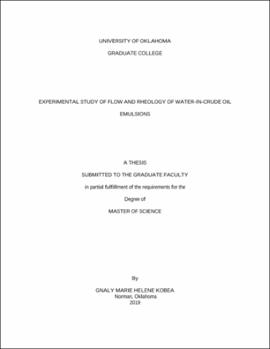| dc.contributor.advisor | Fahes, Mashhad | |
| dc.contributor.author | KOBEA, GNALY MARIE HELENE | |
| dc.date.accessioned | 2019-05-07T15:43:59Z | |
| dc.date.available | 2019-05-07T15:43:59Z | |
| dc.date.issued | 2019-05-10 | |
| dc.identifier.uri | https://hdl.handle.net/11244/319575 | |
| dc.description.abstract | The formation of water-in-crude oil emulsion is one of the main causes of flow assurance issues in petroleum production systems. These mixture exhibit changes in their flow behavior, and the rheological models used to describe them. Minor changes in these properties are the cause of major drawbacks imposed on the production system. It is therefore important to understand the complex behavior of emulsions and identify the properties that create such changes. Most water-in-oil emulsions exhibit a shear thinning behavior. This behavior is obtained through the measurement of the shear rate and shear stress of the emulsion through a rheometer. The power law model is commonly used to characterize the viscosity of shear thinning Non-Newtonian emulsions.
The present work is an investigation of the rheology of water-in-oil emulsions during their flow in pipes. For this purpose, flow experiments were conducted with a 30% water cut water-in-oil emulsion, stabilized by a mixture of two surfactants: 3.5% TX 100 and 3.4% Span 80.The emulsion was circulated in a laboratory scale loop consisting primarily of two stainless steel pipes having outside diameter of 1/4” and 3/8”.The pressure drop, mass flow rate, and viscosity of the emulsion were recorded during the flow of the emulsion. The capillary viscometer was used to measure the viscosity before and after flow. These parameters along with the pipe characteristics were used to estimate the amount of shear exerted during the flow of the emulsions. The shear rate and shear stress derived experimentally showed that at 30% water cut the emulsion was exhibiting a non-Newtonian behavior. The rheology of the emulsion was then characterized using a rheometer. Data from the rheometer showed that the emulsion was exhibiting a Non-Newtonian behavior as well. The shear rate and shear stress from flow and rheometer data were compared and it was observed that the data follow the same trend, however, it was clear that the behavior does not follow the power law model. The effect of these differences on pressure drop estimates in a field scale case was determined. Accordingly, the results were analyzed towards a protocol for the recommended way to characterize similar emulsions. | en_US |
| dc.language | en_US | en_US |
| dc.rights | Attribution-NonCommercial-NoDerivatives 4.0 International | * |
| dc.rights.uri | https://creativecommons.org/licenses/by-nc-nd/4.0/ | * |
| dc.subject | flow in pipes | en_US |
| dc.subject | emulsions | en_US |
| dc.subject | emulsion | en_US |
| dc.subject | rheology | en_US |
| dc.subject | water-in-crude oil emulsions | en_US |
| dc.subject | water in oil | en_US |
| dc.subject | flow behavior | en_US |
| dc.subject | emulions flow in pipe | en_US |
| dc.title | EXPERIMENTAL STUDY OF FLOW AND RHEOLOGY OF WATER-IN-CRUDE OIL EMULSIONS | en_US |
| dc.contributor.committeeMember | Reza, Zulfiquar | |
| dc.contributor.committeeMember | Teodoriu, Catalin | |
| dc.date.manuscript | 2019-04-30 | |
| dc.thesis.degree | Master of Science | en_US |
| ou.group | Mewbourne College of Earth and Energy::Mewbourne School of Petroleum and Geological Engineering | en_US |
| shareok.orcid | 0000-0002-1726-6513 | en_US |

